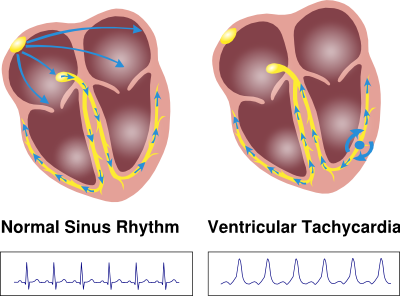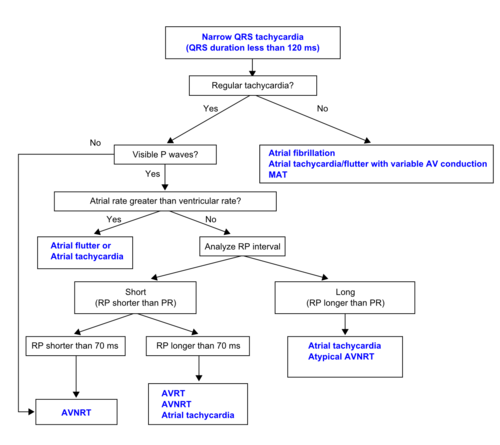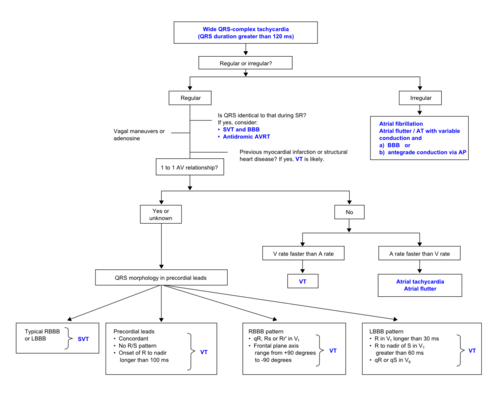Tachycardia: Difference between revisions
| Line 95: | Line 95: | ||
=====Long-Term Management:===== | =====Long-Term Management:===== | ||
The management of AF consist of several key targets. Firstly, any underlying potential reversible cause of AF should be treated. Secondly, care should be taken to prevent the complications of AF. This means that adequate oral-anticoagulation should be initiated and rate control should be started to reduce heart rate. Thirdly, symptoms should be treated with medical or invasive therapy. There are two strategies to reduce symptoms of AF. Rate control is a strategy were a reduction of ventricular heart rate is the main goal. In rhythm control the aim is to maintain sinus rhythm and prevent recurrences of AF.<Cite>Camm2012,Camm2010</Cite> | The management of AF consist of several key targets. Firstly, any underlying potential reversible cause of AF should be treated. Secondly, care should be taken to prevent the complications of AF. This means that adequate oral-anticoagulation should be initiated and rate control should be started to reduce heart rate. Thirdly, symptoms should be treated with medical or invasive therapy. There are two strategies to reduce symptoms of AF. Rate control is a strategy were a reduction of ventricular heart rate is the main goal. In rhythm control the aim is to maintain sinus rhythm and prevent recurrences of AF.<Cite>Camm2012,Camm2010</Cite> | ||
* <B>Rate control:</b> In atrial fibrillation the ventricle can have a fast irregular rate that can lead to complaints of palpitations and a tachycardiomyopathy. One of the strategies in managing atrial fibrillation is to control ventricular rate <110bpm. In patients with persistent complaints or with heart failure a resting heart rate of <80 is advised. In this strategy no attempt is made to achieve sinus rhythm. This is the only treatment option in patients with permanent atrial fibrillation. Due to the fast irregular ventricular rate a dilated tachycardiomyopathy can develop and proper rate control can revert these ventricular changes. Rate control can be achieved with beta-blockers, non-dihydropyridine Ca-antagonists | * <B>Rate control:</b> In atrial fibrillation the ventricle can have a fast irregular rate that can lead to complaints of palpitations and a tachycardiomyopathy. One of the strategies in managing atrial fibrillation is to control ventricular rate <110bpm.<cite>VanGelder1, Groenveld</cite> In patients with persistent complaints or with heart failure a resting heart rate of <80 is advised. In this strategy no attempt is made to achieve sinus rhythm. This is the only treatment option in patients with permanent atrial fibrillation. Due to the fast irregular ventricular rate a dilated tachycardiomyopathy can develop and proper rate control can revert these ventricular changes. Rate control can be achieved with beta-blockers, non-dihydropyridine Ca-antagonists. Digoxine can be added to rate control, however a recent study showed an increase in mortality in patients using digoxine.<cite>Whitbeck</cite> | ||
** <b>Invasive treatment:</b> | ** <b>Invasive treatment:</b> | ||
*** <b>His-Ablation with pacemaker implantation: </b>Patients with accepted atrial fibrillation and complaints of a fast irregular ventricular frequency who do not tolerate medication can be helped with a targeted His bundle ablation with catheter ablation to induce complete AV-block. A implanted pacemaker can take over the ventricular firing frequency independent of the atrium. A pacemaker might be indicated if rate control leads to a iatrogenic bradycardia. | *** <b>His-Ablation with pacemaker implantation: </b>Patients with accepted atrial fibrillation and complaints of a fast irregular ventricular frequency who do not tolerate medication can be helped with a targeted His bundle ablation with catheter ablation to induce complete AV-block. A implanted pacemaker can take over the ventricular firing frequency independent of the atrium. A pacemaker might be indicated if rate control leads to a iatrogenic bradycardia. | ||
Revision as of 08:33, 12 January 2013
Sébastien Krul, MD, Louise Olde Nordkamp, MD, Jonas de Jong, MD
Content is incomplete and may be incorrect. |
Introduction
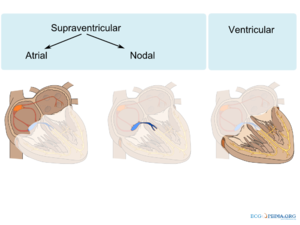
Differentiation between supraventricular tachycardias (SVT) and ventricular tachycardias (VT) can be challenging, especially in acute emergency settings. SVT's are rhythm disturbances in the atria or AV-nodal ring or rhythm disorders in which these structures are involved. Supraventricular arrhythmias are relatively common and rarely life-threatening. VT's are rhythm disorders that only involve the ventricles. It can both take place in the myocardial tissue and the conduction system tissue.
Supra-ventricular tachycardia
Atrial arrhythmias
The following arrhyhmias arise in the atrium. Dependent on the refractory period of the AV-node the ventricles follow the atrial contraction. However, at higher atrial rates the AV-node starts to block conduction from atrium to ventricle.[2, 3]
Sinus Tachycardia
Pathophysiology:
When the sinus node fires with a frequency between 100-180bpm, the term sinustachycardia is used. The maximum heart rate a person can achieve during exercise can be calculated by subtracting the age in years from 210. Usually it is a physiological reaction to stress (exercise, inflammation, stress). External factors can increase the heart rate like coffee and alcohol or drugs. The term inappropriate sinus tachycardia is a persistent increase in resting heart rate or sinus rate unrelated to or an exaggerated response to stress.
Clinical diagnosis:
A sinus tachycardia usually has a gradual start and ending. Diagnosis on the ECG can be made by the morphology of the P-wave. The P-wave has the same morphology during sinus tachycardia as during normal sinus rhythm. An inappropriate sinus tachycardia is diagnosed by when the sinus tachycardia is persistent (therefore non-paroxysmal) and no trigger can be identified.
Management:
No treatment is indicated, usually the sinustachycardia will pass when the external trigger is removed. If patients have persistent complaints, the trigger cannot be removed or in case of a inappropriate sinus tachycardia a beta-blocker can be administered. Patients with a contra-indication for beta-blockers can use nondihydropyridine calcium-channel blockers.
Atrial Tachycardia
Pathophysiology:
Atrial tachycardia (AT) is a tachycardia resulting from fast firing in an ectopic focus or micro-reentry circuit in the atria. It has a frequency of above the 100bpm. In some patients the tachycardia has multiple foci (multifocal atrial tachycardia). This results in different P-wave morphologies on the ECG during the arrhythmia. Atrial tachycardia can be caused by all the mechanisms of arrhythmia formation. Patient after earlier surgery or catheter ablation usually present with macro-reentry AT located around functional or anatomical sides of block. The atrial flutter is a type of AT, but due to its unique mechanism it is discussed separately.
Clinical diagnosis:
ATs have a wide range clinical presentation. They can occur in paroxysms or can be the permanent underlying rhythm. Complaints of palpitation and a fast regular heart rate are common and as a result of the tachycardia complaints of dizziness, dyspnoea and syncope can be experienced. Focal AT that with a progressive increase at onset and decrease before termination are likely based on abnormal automaticity. Digoxine intoxication is a common cause for ATs. On the ECG an atrial tachycardia can be detected through the P-wave morphology. The P-wave has an other morphology depending on the foci of the atrial tachycardia. A ECG in resting condition of sinus rhythm can help distinguish different morphologies and help in localization of the source of the atrial tachycardia. Vagal maneuvers or administration of adenosine can block the AV-conduction and reveal firing from the atrium, thereby clearly identifying the atrial source of the tachycardia. Some ATs are sensitive to adenosine and will terminate after administration of adenosine. However sometimes only a electrophysiological study can differentiate between the different SVT and localize the precise location or circuit of the AT.
Management:
Vagal maneuvers or adenosine can be effective in terminating focal AT. If AT persist and is drug-resistant DC cardioversion can be indicated. Recurrent episodes of AT can be prevented with anti-arrhythmic medication, for instance with beta-blockers or calcium antagonists. However not all AT are sensitive to medication and success rate of medication is usually low. If these drugs are unsuccessful Class Ic in combination with AV-nodal-blocking agents or Class III drugs can be tried. The treatment of choice for symptomatic AT is catheter ablation. In an experienced center up to 90% of the AT can be ablated. Multifocal atrial tachyardia is difficult therapy is usually directed at the management of underlying disease.
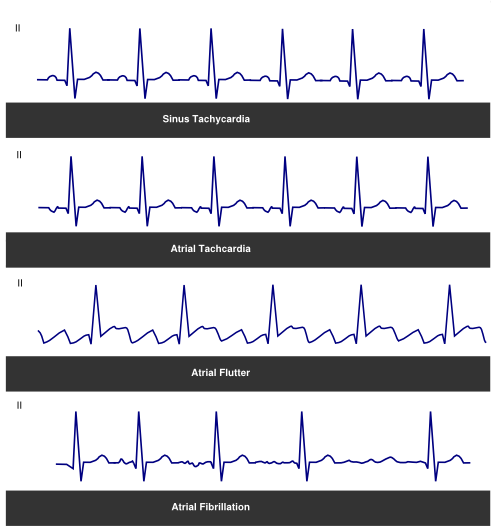
Atrial Flutter
Pathophysiology:
Atrial flutter (AFT) is the most common type of atrial tachycardia. The typical atrial flutter is dependent of the cavotricuspid isthmus. The isthmus between the caval vein and tricuspid is an area of slow conduction. Due to this slow conduction counterclockwise re-entry around the tricuspid annulus can exist. This re-entry produces a typical arrhythmia with activates the atria at a frequency between 250-350 beats per minute. If the re-entry circuit moves counterclockwise a typical AFT is produced. If the re-entry circuit moves clockwise, a atypical AFT is seen. The causes and risk are comparable with atrial fibrillation.
Clinical diagnosis:
An AFT is usually paroxysmal, with a sudden onset, and is diagnosed on the ECG by it typical sawtooth pattern and atrial frequency. Patients experience complaints of palpitations, dyspneu, fatigue or chest pain. An AFT has a frequency of 300 bpm, which conducts to the ventricles in 2:1, 3:1 or 4:1 manner. The P-wave morphology has a sawtooth like appearance and in a typical AFT has a negative vector in the inferior leads. The first part of the P-wave is fast, the second path slow. In a atypical AFT the inferior leads have a positive vector. Atrial fibrillation is a common finding in patients with an atrial flutter (up to 35%).
Management:
In a acute episode a patient with an AFT requires cardioversion. This can be achieved with anti-arrhythmic drugs or electrical cardioversion. Vagal maneuvers increase the AV-block on the ECG and demonstrate the AFT more clearly. Anti-arrhythmic drugs are modestly effective in the acute setting (ibutilide or dofetilide), but have the risk of pro-arrhythmic effects. . DC cardioversion is an effective methods to cardiovert AFT, especially in patients with heart failure or hemodynamic instability. AFT is amendable to catheter ablation and this is the treatment of choice in AFT. Targeted ablation of the area between the inferior vena cava and the tircuspid annulus can block the re-entry circuit. This is a very successful procedure, with few complications in the hands of an experienced electrophysiologist. If patients are not eligible for ablation, anti-arrhythmic drugs class IC or III can be started. However they are of limited efficacy and class IC drugs not be administered without AV-nodal slowing agent because of atrial slowing can result in 1:1 AV conduction. Patients with AFT require anti-coagulation as in atrial fibrillation according to the CHADSVASc score.
Atrial Fibrillation
Pathophysiology:
The pathophysiology of AF is complex and incompletely understood.[4] In most patients the trigger of AF results from extra beats in from the pulmonary veins. This is due to myocardial sleeves growing into the pulmonary veins, which are triggered to fire extra beats due a variety of modulators (e.i. the autonomic nerve system). These triggers can trigger the atria into forming multiple self-perpetuating re-entry circuits. These multiple wavelets, are self-perpetuating circuits than constantly change an move through the atria. The ability of the atria to sustain AF is dependable on atrial structural changes (fibrosis/inflammation). AF induces electromechanical changes in the atrium. These changes make it easier for AF to perpetuate; AF begets AF. Due to the fast and rapid activation of the atria, there is no functional mechanical activity left. This results in the most feared complication of AF, namely forming of blood clots (with for instance stroke as a result). The atrial standstill does not effectively pump blood to the ventricle, and blood can coagulate the left atrium or left atrial appendage. The strokes resulting from AF are often more severe than other causes of stroke. Another complication of AF is a tachycardiomyopathy. Due to the constant chaotic activity in the atria, the AV-node can conduct these signals at high rate. The result is a irregular fast ventricular activation. These fast activation of the ventricle can lead to a (reversible) dilated cardiomyopathy.
Clinical diagnosis:
AF is the most common supraventricular arrhythmia in Western society. Patients can experience complaints from palpitations, dyspnuea and dizziness. It is characterized by the absence of clear P-waves on the surface ECG and an irregular ventricular ventricular rate. On physical examination an irregular pulse can be felt, however this is not diagnostic of AF as other causes can cause an irregular pulse (atrial or ventricular extra systoles).The cardiac output is reduced due to lack of atrial kick. Furthermore due to the higher ventricular rate the heart has not enough time to completely fill with blood. The development of AF is associated with different diseases for instance hypertension, mitral valve disease, thyroid disease and diabetes. AF usually starts with short single isolated episodes of AF which are self terminating. Progressively over time these episodes are of longer duration and occur more frequently. These episodes progress to persistent AF, which last longer than 7 days or can only be terminated by cardioversion. In the end AF is permanent en AF is not possible or duration of sinus rhythm is short. Episodes of AF can be symptomatic, but patients can experience no symptoms during AF. AF is classified according to the clinical presentation of AF:[5]
- Paroxysmal atrial fibrillation: Episodes AF lasting shorter than 7 days and terminating spontaneously usually within 48 hours.
- Persistent atrial fibrillation: Episodes of AF not terminating spontaneously or lasting longer than 7 days or requires cardioversion
- Long standing persistent atrial fibrillation: Persistent AF for more than one year.
- Permanent atrial fibrillation: Accepted AF, no strategies of rhythm control are pursued.
| CHA2DS2VASc score to estimate stroke risk | ||
|---|---|---|
| Risk Factor | Points | |
| C: | Congestive heart failure | [1 point] |
| H: | Hypertension | [1 point] |
| A: | Age>75years | [2 point] |
| D: | Diabetes | [1 point] |
| S: | Stroke/Embolism | [2 points] |
| V: | Vascular Disease | [1 point] |
| A: | Age>65years | [1 point] |
| Sc: | Female Sex | [1 point] |
Management:
Acute Management:
The acute management of AF depends on the presentation of the patient. In stable patients with little complaints, rate control can be initiated with beta-blockers, non-dihydropyridine Ca-antagonists and digoxine. If the patient has recent onset of AF, is highly symptomatic or hemodynamicly compromised, cardioversion is indicated. Cardioversion can be performed medically or with electricity. Most effective drug is flecainide, although this drug is contra-indicated in patients with structural heart disease. Another optien is Ibutilide, but this is mostly used to terminate atrial flutter, and has a small change of ventricular arrhythmias. In patients with severe structural heart disease amiodarone can be given. Electrical cardioversion can achieved by a DC shock after sedation of the patient. If the AF persist for longer than >48 hours or the start of the episode is not clear, anti-coagulation should be initiated before (medical or electrical) cardioversion. Three weeks of anti-coagulation is advised before cardioversion and it should be continued after cardioversion for 4 weeks to minimize thromboembolic risk.
Long-Term Management:
The management of AF consist of several key targets. Firstly, any underlying potential reversible cause of AF should be treated. Secondly, care should be taken to prevent the complications of AF. This means that adequate oral-anticoagulation should be initiated and rate control should be started to reduce heart rate. Thirdly, symptoms should be treated with medical or invasive therapy. There are two strategies to reduce symptoms of AF. Rate control is a strategy were a reduction of ventricular heart rate is the main goal. In rhythm control the aim is to maintain sinus rhythm and prevent recurrences of AF.[5, 6]
- Rate control: In atrial fibrillation the ventricle can have a fast irregular rate that can lead to complaints of palpitations and a tachycardiomyopathy. One of the strategies in managing atrial fibrillation is to control ventricular rate <110bpm.[7, 8] In patients with persistent complaints or with heart failure a resting heart rate of <80 is advised. In this strategy no attempt is made to achieve sinus rhythm. This is the only treatment option in patients with permanent atrial fibrillation. Due to the fast irregular ventricular rate a dilated tachycardiomyopathy can develop and proper rate control can revert these ventricular changes. Rate control can be achieved with beta-blockers, non-dihydropyridine Ca-antagonists. Digoxine can be added to rate control, however a recent study showed an increase in mortality in patients using digoxine.[9]
- Invasive treatment:
- His-Ablation with pacemaker implantation: Patients with accepted atrial fibrillation and complaints of a fast irregular ventricular frequency who do not tolerate medication can be helped with a targeted His bundle ablation with catheter ablation to induce complete AV-block. A implanted pacemaker can take over the ventricular firing frequency independent of the atrium. A pacemaker might be indicated if rate control leads to a iatrogenic bradycardia.
- Invasive treatment:
- Rhythm control: In rhythm control all efforts are made to achieve and maintain sinus rhythm. This can be done with anti-arrhythmic drugs. Most effective are the Class IC and III anti-arrhythmic drugs. Overall rhythm control is difficult and anti-arrhythmic drugs might have (pro-arrhythmic) side effects, if patients have contra-indications. Therefore prescription of these drugs should occur with caution.
- Invasive treatment:[10]
- Catheter ablation: Medical therapy is not always sufficient to maintain sinus rhythm. In the last decade of 20th century it was discovered that atrial fibrillation is triggered from the pulmonary veins and that selective ablation of these trigger sites can reduce atrial fibrillation recurrence.[11] As this technique evolved it is now common to ablate an area around the pulmonary veins to isolate them from the atrial tissue. The left atrium is approached through the inter-atrial septum and with the use of imaging and electrocardiographic signals a 3D map is made to navigate the atria. The pulmonary vein isolation can be performed with multiple energy sources (cryo-cooling, radiofrequent energy). This is a complex procedure, that depending on the technique used has a minor chance of (severe) complications, primarily caused by damage of the surrounding structures. The success rate of the procedure varies on the experience of the operator and is 57-71% after one or more procedures.[12, 13] Catheter ablation is suitable for patients with a with drug-refratory rhythm control strategy.[14] Certain selected patients with heart failure might benefit from catheter ablation, although success are lower.[15, 16]
- Surgical treatment: Surgery is a more invasive, but effective modality to treat atrial fibrillation. The classical cut and sew Maze procedure is a open chest procedure that requires extra-corporeal circulation. In this procedure the atrium is cut and sewn again to compartmentalize the atrium en therefore prevent the atrium maintaining atrial fibrillation.[17, 18] In recent years a less invasive procedure has developed to treat atrial fibrillation. This minimal invasive surgery is performed through thoractomy or thoracoscopy and is performed on a beating heart.[19] A pulmonary vein isolation is performed with a clamp and if patients have persistent atrial fibrillation additional left atrial lesions are made on the atrium to compartmentalize the atrium. Finally the left atrial appendage is removed to reduce the occurrence of stroke. This procedure has a success rate of 68% after one year.[20, 21, 22] Recently hybrid surgical procedures have been described that combine the minimal invasive thoracoscopic surgery with (epicardial or endocardial) elektrophysiological measurement. Patients with a large left atrium (diameter>45mm) or a failed catheter ablation are eligible for AF surgery.[23, 24]
- Invasive treatment:[10]
Studies have shown no benefit of rhyhtm control over rate control, thus the selection of strategy is mainly dependent of patient and atrial fibrillation characteristics. This means that, since rate control is easier to achieve, rate control should be the initial strategy in all patients, especially in old patient and patients with no or few symptoms of atrial fibrillation. The target heart rate to achieve in rest is <110 beats per minute. In patients with persistent complaints of atrial fibrillation rhythm control can be initiated on top of rate control. Young patients with paroxysmal atrial fibrillation and no underlying heart disease might benefit from early (invasive) rhythm control to halt progression of the disease. However, independent of the treatment strategy, proper anti-coagulation is important and necessary in patients with risk factors.[5, 6]
- Anticoagluation treatment: Proper anti-coagulation is important in patients with atrial fibrillation to reduce the occurrence of stroke. In patient with atrial fibrillation the indication of anti-coagulation is based on certain risk-factors a patients has. A score is created to facilitate this decision making. The CHADS2VASc2 score incorporates these risk factors. A patient has no indication for anti-coagulation if there is a low-risk of thromoembolic complications.[25, 26] These patients are defined as males or females <65 years old with no other risk factors. This translates is a CHADSVASc score of 0, or a CHADSVASc score of 1, where 1 point is based on the female sex. In all other cases anti-coagulation with coumarins or other new anticoagulation drugs (dabigatran, rivaroxiban, apixaban)[27, 28, 29] is indicated if no strong bleeding-risk exist. It is important to note that anti-coagulation is independent of the underlying rhythm.
AV node arrhythmias
This section covers the arrhythmias in which the AV node is critical in maintaining the arrhythmia. Most of these arrhythmias share the common characteristic that AV-node blocking or delaying manoeuvres or medication (adenosine) can terminate the arrhythmia.[2, 3]
AV junctional tachycardia
An AV junctional tachycardia is a tachycardia resulting from regular frequent firing (110-250 bpm) of the AV-node. It has the characteristics of a small QRS with a retrograde or no P-wave. The P-wave is not always visible because it can be hidden in the QRS complex. If it is visible it is negative in the inferior leads and narrow, suggesting an AV-nodal origin. The small QRS is not preceded by a p-wave as atrium and ventricle are both activated from the AV-node. For management of this arrhythmia variable success is achieved with anti-arrhythmic drugs.
Atrioventricular Nodal Reciprocating Tachycardia (AVNRT)
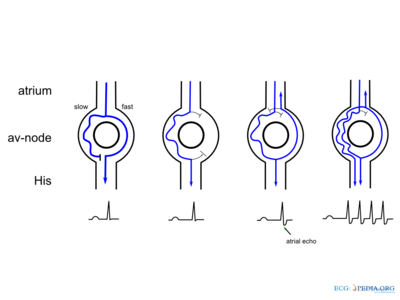
Pathophysiology:
AVNRT is a regular arrhythmia relying on the dual AV-physiology for its maintenance. The AV-node usually has two pathways in these patients; a fast pathway with fast conduction times and a slow pathway which conducts slowly. The fast pathway has a longer refractory period than the slow pathway. Due to these characteristics re-entry formation is possible. Normally the impulse from the atria is conducted through the fast pathway to the ventricle. The impulse also travels through the slow pathway, but reaches tissue still in the refractory period at the end of the AV-node (as the fast pathway has already conducted the impulse and activated this part of the AV-node). When an extra premature atrial contraction occurs it encounters a refractory fast-pathway (which has a longer refractory period). It enters the slow pathway and when it reaches the end of this pathway it can conduct to the (now restored) end of the AV-node to the ventricles and back into the fast pathway. The result is a ventricular activation with a retrograde P-wave. If the slow pathway is restored when the impulse reaches the beginning (atrial side) of the fast pathway, the impulse can re-enter the slow-pathway and a re-entry mechanism is established. This is the mechanism of a typical AVNRT, which is found in 90% of the patient with an AVNRT. Two other forms of AVNRT exist that take a different route through the AV-node. Firstly there is an atypical AVNRT in which the impulse travels through the fast pathway and returns through the slow pathway. The result of this AVNRT is a retrograde P-wave which appears far from the QRS complex. Finally there is a rare AVNRT which in patients with two slow pathways. The impulse enters en re-enters through a slow pathway.
Clinical diagnosis:
It is a fast regular small complex tachycardia with a frequency of 180-250 bpm. It is more common in women than in men (3:1) and has a sudden onset. Palpitation are experienced due to the fast regular heartbeat. The Frog sign can be observed; neck vein pulsations which occur due to simultaneous contraction of the atria and ventricles. The atria cannot empty into the ventricles and therefore expulse their contents into the venous circulation. A typical AVNRT can be diagnosed on the ECG by a RP distance of 100ms. The P wave is sometimes hidden in the QRS complex or appears directly after the QRS complex. An atypical AVNRT has a retrograde P appearing far away from the QRS, as it has to travel through the slow pathway. A registration of the onset can often be quite helpful in establishing the diagnosis AVNRT.
Management:
Termination of acute episodes is possible by vagal maneuvers (blowing on the wrist, carotid sinus massage) or medication (adenosine, verapamil, diltiazem). If vagal maneuvers or medication fail ECV can be performed. Catheter ablation can be the treatment of first choice in AVNRT. Electrophysiological studies can demonstrate dual AV-node physiology and evoke the arrhythmia in these patients. Selective ablation of the slow pathway has a high success rate (up to 98%) and the risk of inducing AV-block is low (<0,5%). Long term medical therapy can be initiated in patients not suitable for catheter ablation, or who do not desire a catheter ablation. Calcium channel blocker, beta-blockers and digoxin are used as first option or in a pill in the pocket approach. Other options are class IC or class III anti-arrhythmic drugs.
AV Re-entry Tachycardia (AVRT)
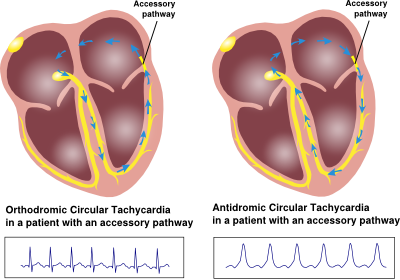
Pathophysiology:
AVRT are tachycardias with a re-entry circuit comprising the entire heart. The atria, AV-node, ventricles and an extra bundle are the essential parts of this circuit. The pre-requisite for an AVRT is the existence of an extra bundle between the atrium and the ventricle. This bundle can bypass the AV-node and connect directly to the His bundle, ventricular myocardium or one of the fascicles. Bundles have variety of anatomical locations and can even run epicardially. The conduction direction of these bundles can be anterograde (atrium-ventricle), retrograde (ventricle-atrium) or bidirectional. Some of the bundles exhibit AV-nodal like conduction properties, these are also known as Maheim bundles. If a bundle can conduct anterograde at a high rate (a refractory period of <260ms), then a risk of VF exists if the patients develops AF due to fast conduction of fibrillatory activity. Depending on the conduction characteristics of the bundle and the direction of conduction two different AVRT circuits can manifest:
- Orthodrome AV re-entry tachycardia: The impulse travels through the normal conduction system in the standard direction and returns to the atria via the accessory bundle.
- Antidrome AV re-entry tachycardia: The impulse travels antrograde through the accessory bundle and activates the ventricles. The impulse returns through the normal conduction system to the atria.
Clinical diagnosis:
If an accessory bundle excites the ventricle earlier than normal AV-conduction, thus has antegrade conduction properties, and can activate the ventricles, pre-excitation is visible on the ECG. This is a can be visible on the ECG by a shortened PQ interval and a widened QRS complex of >120ms due to slurring of the QRS complex (delta wave). This is also called the Wolf-Parkison-White symptom and can occur intermittently. If a patient has pre-excitation and complaints of arrhythmia caused by an AVRT the combination of these two is called the Wolf-Parkinson-White syndrome. Some patient have an AVRT, but no traces of pre-excitation. The bundle is then called a concealed bundle. Patients can be asymptomatic if they only have pre-exitation and this ECG pattern is commonly an incidental finding. When an arrhythmia develops using the accessory bundle, both types of AVRT can develop depending on the conduction characteristics of the bundle:
- Orthodrome AV re-entry tachycardia: There is a P-wave (other morphology than sinus rhythm) followed by small QRS-complex
- Antidrome AV re-entry tachycardia: This is a broad-complex tachycardia, where the broad QRS complex is followed by a retrograde P-wave originating from the AV-node.
Management:
The circuit of the arrhythmia uses the AV node, therefore vagal maneuvers are able to terminate the AVRT. However adenosine should be used with care, as it may induce AF and cause 1:1 conduction. Anti-arrhythmic drugs (Class IC, II, III, IV) can be useful to prevent paroxysms of arrhythmia, and a pill-in-the-pocket approach can be used for patients with infrequent episodes. Catheter ablation can target the accessory pathway and destroy the bundle. The success of the procedure is dependent on the location of the bundle as not all anatomical positions are easily targeted with ablation. It is controversial if patients with an asymptomatic WPW ECG pattern and no co-morbidities should have an ablation. To determine the risk of 1:1 conduction, an exercise test can be performed to determine the response of the accessory bundle to an increased atria rate. If the pre-exitations persists an electrophysiological procedure can be performed to assess the conduction properties of the accessory bundle. While the characteristics of the bundle predict the risk for an event, the life-style and\or profession of the patient can influence the decision for ablation.[30]
Ventricular tachycardia
Ventricular tachycardias (VT's) are rhythm disturbances that arise in the ventricles.
History
Symptoms can arise in every ventricular tachycardia, depending on the heart rate, the presence of underlying heart disease and the degree of systolic and diastolic heart failure.
Various symptoms are:
- Palpitations
- Abnormal chest sensation
- Dyspnea
- Angina
- Presyncope (lightheadedness, weakness, diaphoresis)
- Syncope
- Cardiogenic shock
The patient’s age and previous medical history are essential. The chance that a wide complex tachycardia in a 70 year old man with previous myocardial infarction is a VT (vs. SVT with aberrancy) is >90%. Additional information about drug use is mandatory. Toxic levels of digoxin and cocain can lead to VT's. Also additional information about family history of sudden cardiac death is helpful, as it is a strong predictor of susceptibility to ventricular arrhythmias and sudden cardiac death.
Physical Examination
Although the diagnosis of VT is generally made by a 12 lead ECG, the following physical symptoms may be present:
- Decreased or variable amplitude of the carotid or peripheral pulses. This is related to the intermittent periods of atrial and ventricular synchronization, which transiently augment cardiac output.
- Cannon A waves on the jugular venous pulse in the neck. These represent intermittant retrograde propulsion of blood into the jugular veins during right atrial contraction against a closed AV valve. This is evidence of AV dissociation.
- Variable intensity of the first heart sound (although this is difficult with a rapid heart rate).
- Variable splitting of the first and second heart sounds, and intermittent presence of a third and/or fourth heart sound.
Diagnostic Evaluation
- Exercise testing: Exercise testing is recommended in adult patients with ventricular tachycardias who are now in sinus rhythm to detect coronary heart disease. It is meant to provoke ischemic changes or ventricular arrhythmias.
- Ambulatory (Holter) ECG: Ambulatory ECG is necessary if the diagnosis needs to be clarified, by detecting arrhythmias, QT-interval changes, T-wave alternans (TWA) or ST-segment changes.
- Echocardiography, Cardiac CT, MRI: Echocardiography is recommended in patients with ventricular tachycardias who are suspected of having structural heart disease. If echocardiography does not provide accurate assessment of the left and right ventricular function and/or structural changes, cardiac CT or MRI can be done.
- Exercise testing with an image modality (echocardiography or nuclear perfusion): Some patients with ventricular arrhythmias have an intermediate probability of coronary heart disease, but their ECG is less reliable (because of digoxin use, LVH, greater than 1mm ST-segment depression at rest, WPW syndrome or LBBB). For detecting silent ischemia in these patients exercise testing with an image modality can be done. If patients are unable to perform exercise, a pharmacological stress test with an imaging modality can be done.
- Coronary angiography: Coronary angiography can diagnose or exclude the presence of significant obstructive coronary heart disease in patients with ventricular arrhythmias who have an intermediate or greater probability of having coronary heart disease.
- Electrophysiological testing: Electrophysiological testing can be performed to guide and assess the efficacy of VT ablation in patients with ventricular arrhythmias. It can also be done to clarify the mechanism of broad complex tachycardias in patients with coronary heart disease.
Overview of ventricular tachycardias
| example | regularity | atrial frequency | ventricular frequency | origin (SVT/VT) | p-wave | effect of adenosine | |
|---|---|---|---|---|---|---|---|
| Wide complex (QRS>0.12) | |||||||
| Ventricular Tachycardia | File:Vt small.svg | regular (mostly) | 60-100 bpm | 110-250 bpm | ventricle (VT) | AV-dissociation | no rate reduction (sometimes accelerates) |
| Ventricular Fibrillation | File:Vf small.svg | irregular | 60-100 bpm | 400-600 bpm | ventricle (VT) | AV-dissociation | none |
| Ventricular Flutter | File:Vflutt small.svg | regular | 60-100 bpm | 150-300 bpm | ventricle (VT) | AV-dissociation | none |
| Accelerated Idioventricular Rhythm | File:Aivr small.svg | regular (mostly) | 60-100 bpm | 50-110 bpm | ventricle (VT) | AV-dissociation | no rate reduction (sometimes accelerates) |
| Torsade de Pointes | File:Tdp small.svg | regular | 150-300 bpm | ventricle (VT) | AV-dissociation | no rate reduction (sometimes accelerates) | |
| Bundle-branch re-entrant tachycardia* | regular | 60-100 bpm | 150-300 bpm | ventricles (VT) | AV-dissociation | no rate reduction | |
| * Bundle-branch re-entrant tachycardia is extremely rare | |||||||
Ventricular tachycardia
Ventricular tachycardia (VT) is defined as a sequence of three or more ventricular beats. The rate is often 110-250 bpm. Ventricular tachycardias often origin around old scar tissue in the heart, e.g. after myocardial infarction. Also electrolyte disturbances and ischemia can cause ventricular tachycardias. The cardiac output is often strongly reduced during VT resulting in hypotension and loss of consciousness. VT is a medical emergency as it can deteriorate into ventricular fibrillation and thus mechanical cardiac arrest.
Definitions
- Non-sustained VT: Three or more ventricular beats with a maximal duration of 30 seconds.
- Sustained VT: A VT of more than 30 seconds duration (or less if treated by electrocardioversion within 30 seconds).
- Monomorphic VT: All ventricular beats have the same configuration.
- Polymorphic VT: The ventricular beats have a changing configuration. The heart rate is 100-333 bpm.
- Biphasic VT: A ventricular tachycardia with a QRS complex that alternates from beat to beat. Associated with digoxin intoxication and long QT syndrome.
Localisation of the origin of a ventricular tachycardia
Determination of the location (or exit site) where a ventricular tachycardia originated can be helpful in understanding the cause of the VT and is very helpful when planning an ablation procedure to treat a ventricular tachycardia. The location can be determined with the QRS morphology:
- RBBB/LBBB morphology:
- RBBB: origin in the left ventricle
- LBBB: origin in the right ventricle
- Inferior/superior axis (lead II, III and aVF):
- Inferior axis (positive in lead II, III and aVF): origin superior wall
- Superior axis (negative in lead II, III and aVF): origin inferior wall
- Basal/apical (lead V5-V6):
- Positive concordance in V5-6: basal origin
- Negative concordance in V5-6: apical origin
Differential diagnosis
(Non)sustained VT may be idiopathic, but occurs most frequently in patients with underlying structural heart disease of various types including:
- Coronary heart disease (CHD) with prior myocardial infarction (is the most frequent cause in developed countries)
- Hypertrophic cardiomyopathy
- Dilated cardiomyopathy
- Mitral valve prolapse
- Aortic stenosis
- Complex congenital heart disease
- Cardiac sarcoidosis
- Arrhythmogenic RV cardiomyopathy/dysplasia
Treatment
Hemodynamical instability:
- Electrocardioversion
Haemodynamical stability in a regular monomorphic broadcomplex tachycardia (systolic blood pressure >100 mmHg):
- Pharmacological treatment can be considered with Procaïnamide or Amiodaron
Ventricular flutter
Ventricular flutter is a ventricular tachycardia that occurs at a very rapid rate (often around 300 bpm) and results from re-entry. The QRS complexes are regular and usually monomorphic and show a typical sinusoidal pattern. During ventricular flutter the ventricles depolarize in a circular pattern at a high rate, which prevents good function. Most often this results in a minimal cardiac output and subsequent ischemia. Often deteriorates into ventricular fibrillation.
Treatment
Electrocardioversion is the only treatment for ventricular flutter.
Ventricular fibrillation
Ventricular fibrillation (VF) is identified by the complete absence of properly formed QRS complexes. Instead of uniform activation of the ventricular myocardium, there are uncoördinated series of very rapid, ineffective contractions of the ventricle caused by many chaotic electrical impulses. In recent onset VF the electrical activity is of higher amplitude at rates greater than 320 bpm, which manifest random changes in morphology, width and height. It appears as a completely chaotic rhythm. If VF continues, the fibrillatory waves become fine and can resemble asystole in these cases.
Treatment
VF is lethal if the patient is not treated immediately. It gives rise to a mechanical standstill of the heart, because there is no pump function. Electrocardioversion is the only treatment for ventricular fibrillation.
Accelerated idio-ventricular rhythm
Accelerated idioventricular rhythm (AIVR) is a relatively benign form of ventricular tachycardia. It is (mostly) a regular repetitive ventricular rhythm rate around 60-120 bpm, but mostly 80-100. It is the result of an enhanced ectopic ventricular rhythm, which is faster than normal intrinsic ventricular escape rhythm (<40 bpm), but slower than ventricular tachycardia (over 100-120 bpm). It often occurs during reperfusion after a myocardial infarction. AIVR is not a predictive marker for early VF; however, recent debate has started whether among patients with successful coronary intervention, AIVR is a sign of ventricular dysfunction and therefore a slightly worse prognosis. AIVR can also occur in infants. By definition, AIVR is a ventricular rhythm of no more than 20% faster than the sinus rate and occuring in the absence of other heart disease. This arrhythmia typically resolves spontaneously during the first months of life (in contrast to an infant with incessant VT which can be due to discrete myocardial tumors or congenital cardiomyopathy).
Treatment
AIVR is generally a transient, self-limiting rhythm and resolves as sinus rate surpasses the rate of AIVR. It rarely causes hemodynamic instability and rarely requires treatment.
Torsades de Pointes
Torsades de pointes (TdP) is a ventricular tachycardia associated with a prolonged QTc interval on the resting ECG. The ECG during TdP is characterized by twisting of the peaks of the QRS complexes around the isoelectric line during the arrhythmia (changing axis). Torsade de pointes is typically initiated by a short-long-short interval. A ventricle extrasystole (first beat: short) is followed by a compensatory pause. The following beat (second beat: long) has a longer QT interval. If the next beat follows shortly thereafter (third beat: short), there is a good chance that this third beat falls within the QT interval, resulting in the R on T phenomenon and subsequent Torsades de pointes.
See the chapter on LQTS for a list of medication and genes that can cause QT prolongation and TdP.
Treatment
Electrocardioversion is the first treatment for an unconcious patient with incessant TdP.
Additional treatments are:
- Withdrawal of any offending drugs and correction of electrolyte abnormalities (potassium repletion up to 4.5 to 5 mmol/liter, the goal should be to make the patient slightly hyperkalemic).
- Acute and long-term cardiac pacing in patients with TdP presenting with heart block, symptomatic bradycardia or recurrent pause-dependent TdP
- Intravenous magnesium sulfate can be helpful to cardiovert TdP in the acute phase in patients with few TdP episodes. If recurrence occurs a continues infusion may be beneficial.
- Beta blockers combined with cardiac pacing as acute therapy for patients with TdP and sinus bradycardia. This prevents extrasystoles and thereby short-long-short sequences.
- Isoproterenol as temporary treatment in patients with recurrent pause-dependent TdP who do not have congenital long QT syndrome.
Differentiation between SVT and VT
To differentiate between supraventricular tachycardias and ventricular tachycardias a 12 lead ECG is the cornerstone of the diagnostic process. At first, the physician has to make a differentiation between a small or broad complex tachycardia.
Definitions
- Narrow complex tachycardia: QRS duration < 120 ms.
A narrow complex tachycardia is most likely to be a SVT. However, also a septal VT or His-tachycardia can appear as a narrow complex tachycardia.
- Wide complex tachycardia: QRS duration > 120 ms.
A wide complex tachycardia can be due to a SVT with aberration, pre-exited tachycardia (eg antidrome re-entry tachycardia) or VT.
Differentiation
These are the flow charts of a small and wide complex tachycardia to differentiate between the different rhythms:
Treatment
- Haemodynamical instable (systolic blood pressure less than 100 mmHg):
- Electrical cardioversion (with anesthesia when concious)
- Haemodynamically stable regular narrow complex tachycardia:
- Carotid massage (after palpation and ausculatation of carotid arteries for exclusion of carotid occlusion/stenosis)
- Vasalva manoeuvre
- Adenosine bolus (if patient is not asthmatic or having COPD)
- Verapamil (if patient is not having systolic heart failure)
- Beta-blocker (if patient is not having systolic heart failure)
References
Error fetching PMID 14999113:
Error fetching PMID 14557344:
Error fetching PMID 20802247:
Error fetching PMID 22922413:
Error fetching PMID 22386883:
Error fetching PMID 21248168:
Error fetching PMID 2008095:
Error fetching PMID 2008096:
Error fetching PMID 16153931:
Error fetching PMID 22082673:
Error fetching PMID 22078990:
Error fetching PMID 22034920:
Error fetching PMID 22782971:
Error fetching PMID 22742400:
Error fetching PMID 23094720:
Error fetching PMID 9725923:
Error fetching PMID 19808490:
Error fetching PMID 18946063:
Error fetching PMID 15575053:
Error fetching PMID 20966417:
Error fetching PMID 19762550:
Error fetching PMID 19717844:
Error fetching PMID 21830957:
Error fetching PMID 21870978:
- Error fetching PMID 14557344:
- ISBN:9780199566990
- Error fetching PMID 21248168:
- Error fetching PMID 20802247:
- Error fetching PMID 22922413:
- Error fetching PMID 22386883:
- Error fetching PMID 9725923:
- Error fetching PMID 19808490:
-
=19808490
- Error fetching PMID 23094720:
- Error fetching PMID 18946063:
- Error fetching PMID 15575053:
- Error fetching PMID 22078990:
- Error fetching PMID 22742400:
- Error fetching PMID 19717844:
- Error fetching PMID 21830957:
- Error fetching PMID 21870978:
- Error fetching PMID 22579340:
- Error fetching PMID 14999113:
- Error fetching PMID 2008095:
- Error fetching PMID 2008096:
- Error fetching PMID 16153931:
- Error fetching PMID 22082673:
- Error fetching PMID 22034920:
- Error fetching PMID 22782971:
- Error fetching PMID 20966417:
- Error fetching PMID 19762550:
